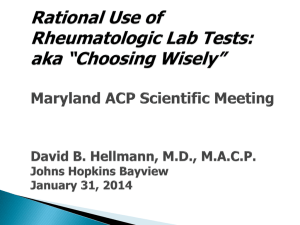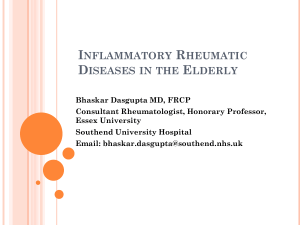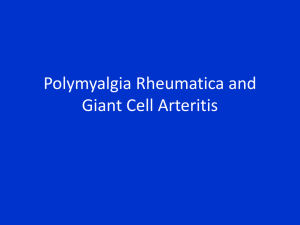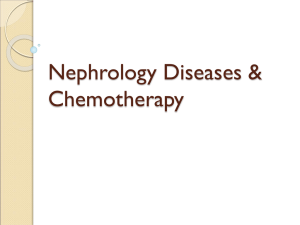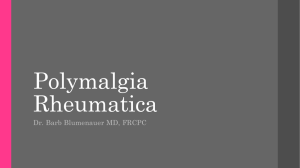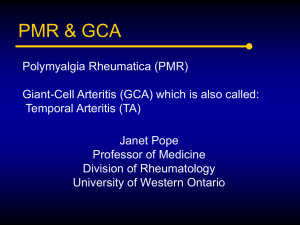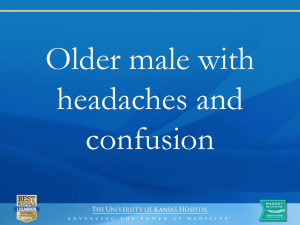Vasculitis.ppt
advertisement
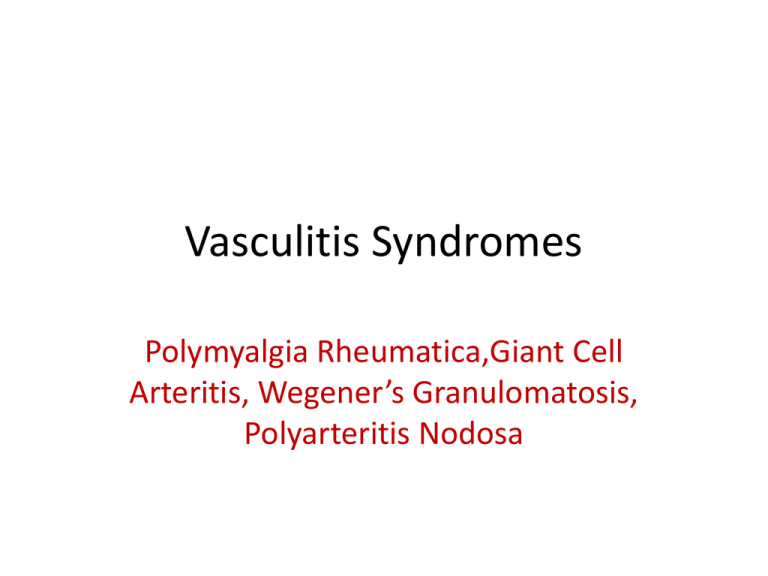
Vasculitis Syndromes Polymyalgia Rheumatica,Giant Cell Arteritis, Wegener’s Granulomatosis, Polyarteritis Nodosa What is Vasculitis? • Disease characterized by inflammation of blood vessel walls, leading to altered blood flow through obstructed walls. This causes ischemia and tissue damage. • In addition there is an intense inflammatory rxn causing further systemic signs and symptoms • Can be fatal You Should Suspect Vasculitis • • • • • • • • • • • Unexplained signs and sxs Multisystem disease Unexplained elevated ESR/CRP Skin lesions (palpable purpura) Ischemic vascular changes (Raynaud’s, gangrene, livedo, claudication) Glomerulonephritis Mononeuritis multiplex Intestinal angina Inflammatory ocular diease Arthalgias/arthritis, myalgias Sudden visual loss/headache Select Vasculitides • Polymyalgia Rheumatica • Giant Cell or Temporal Arteritis • Wegener’s Granulamatosis • Polyarteritis Nodosa Polymyalgia Rheumatica (PMR) • Most ‘benign‘ of the group • Common: 50/100,000, age > 50, average age 75. Highest prevalence in northern European ancestry, females>>males • Cause unknown PMR Clinical Presentation • Usually abrupt onset • Intense morning stiffness and pain that can last all day involving the shoulders and hip girdle area • No small joint involvement • Muscle strength normal • Fatigue and anorexia common • Elevated CRP and ESR; anemia of chronic disease, elevated platelets • 15% get GCA (more later) PMR Treatment • Low Dose Steroids (10-20 mg/day) – The only drug that works – Look to normalize the CRP and ESR; if they continue to be elevated, rethink the dx (?paraneoplastic syndrome or GCA) – Usually self-limited: 65% of patients able to taper off Prednisone by 1 year, >85% in 2 years – Disease flares not uncommon as prednisone is tapered and may require dose adjustments Giant Cell Arteritis • • • • • Can occur exclusively but often seen with PMR Rare: 15/100,000 Age >50 Cause unknown Involves the medium/large blood vessels of the head and neck including the blood vessels that supply the optic nerve GCA Pathophysiology • Unknown trigger causes inflammatory response with the release of IL-1 and IL-6. • This leads to systemic symptoms and the infiltration of inflammatory cells into the adventitia of the temporal and other involved arteries • Typical histologic pattern: Giant Cells GCA Clinical Presentation • • • • • • • Variable Scalp tenderness Temporal headaches Jaw Claudication Sudden loss of vision +/- PMR sxs Rare- upper extremity claudication due to subclavian involvement • Constitutional sxs: FUO, wt loss, fatigue • Bounding OR absent temporal artery pulses • Rarely subclavian bruits GCA Diagnostic Studies • Temporal Artery Biopsy is the gold standard • Elevated ESR and CRP, usually levels higher than in PMR • Anemia • Elevated LFTs not uncommon Treatment of GCA • High dose Steroids (60 mg/day) is the only drug that works • Slow taper over time usually 1-2 years. Some patients require low dose (<10 mg/day) chronically GCA Complications • • • • Blindness Scalp Necrosis Lingual Infarction Aortic Dissection/Aneurysm • Complications from high dose steroids: osteoporosis, cataracts, elevated blood sugars, wt. gain etc. Wegener’s Granulomatosis (WG) • Potentially fatal vasculitis involving small vessels • Rare: 3-14/million, more common in whites, any age but rare in children • Pathology shows necrotizing granulomas usually in upper airways, lungs and kidneys WG Pathophysiology • Complex immunopathogenic events in which the production and activity of ANCAs (usually c-ANCA) play a central role. These autoantibodies interact with primed neutrophils to cause vascular injury and necrosis. • Histologic lesions show granulomas WG Clinical Presentation • Variable, multisystem involvement • Organs: – Eyes: episcleritis/scleritis, proptosis due retro-orbital mass – CNS: rare mass lesion – Upper airway: otitis media, nasal chondritis, sinusitis with purulent drainage and epistaxis, ulcerations, subglottic stenosis – Kidney: neprotic syndrome, proteinuria, renal failure – Skin: palpable purpura due to leukocytoclastic vasculitis, pyoderma gangrenosum, panniculitis – Lung: cough, hemoptysis, hemorrhage, resp failure – Cardiac: pericarditis, conduction abnormalities – Systemic: fever, night sweats, wt loss, fatigue Palpable Purpura Eye Involvement Face Involvement WG Diagnostic Studies • Presence of c-ANCA (cytoplasmic staining pattern antineutrophil cytoplasmic antibodies + clinical picture is often enough to make the diagnosis. It is + 80-90% of generalized WG. • If the c-ANCA is -, tissue biopsy of lung or kidney is recommended. • “Limited” refers to disease limited to the airways; c-ANCA often is -. Additional labs • • • • Elevated CRP and ESR Anemia, leukocytosis, & thrombocytosis Elevated Cr Active urine sediment with red cell casts, hematuria and proteinuria WG Clinical Course/Progression • Prior to immunosuppression therapies, WG was uniformly fatal. Now survival rates almost 90% with aggressive treatment. • High dose steroids and Cyclophosphamide are cornerstone of therapy. Methotrexate or Azathioprine sometimes used as steroid sparing agents. Polyarteritis Nodosa (PAN) • • • • Medium vessel vasculitis Can be caused by Hep B 5/million cases Peak incidence 50’s & 60’s, slightly more common in males PAN Pathophysiology • In Hep B assoc cases immune complexes play significant role • In non Hep B cases, the pathophysiology is less understood PAN Clinical Presentation • Systemic: fever, fatigue, wt loss • Abdominal pain due to mesenteric angina/ischemia • Mononeuritis multiplex • Myalgias/arthalgias/mild arthritis • Hypertension • Skin: livedo reticularis, palpable purpura, fingertip ulceration, subcutaneous nodules • Testicular pain or tenderness Livedo reticularis Subcutaneous Nodules Complications of PAN • • • • Chronic renal failure Bowel perforation Stroke/cerebral hemorrhage due to HTN Foot/wrist drop Wrist Drop Labs of PAN • Elevation of acute phase reactants (ESR, CRP etc) • Absence of ANCA • Elevated transaminases, decreased albumin • +/- Hep B • Urine: proteinuria and hematuria without casts Imaging Studies of PAN • Mesenteric and/or renal angiography is the test of choice • Biopsies seldom done Angiogram PAN Treatment • High dose steroids and Cyclophosphamide • Methotrexate or Azathioprine is used as steroid sparing agents later once the disease is controlled • Treatment for Hep B with antivirals. Sometimes plasma exchange is used to remove immune complexes

